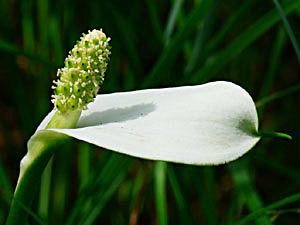
medicinal herbs
Water Arum
Calla palustris

Herb: Water Arum
Latin name: Calla palustris
Family: Araceae (Arum Family)
Medicinal use of Water Arum:
Antirheumatic. Used in the treatment of colds and flu. A tea made from the dried root has been used in the treatment of flu, shortness of breath, bleeding and as a poultice on swellings and snakebites. The aerial stems have been used in the treatment of sore legs.Description of the plant:

Plant:
Perennial
Height:
25 cm(9 3/4 inch)

Flowering:
Juneto July
Habitat of the herb:
Forest swamps, moorland marshes, by ponds and streams.Edible parts of Water Arum:
Rhizome - cooked. It is usually prepared by drying the root, grinding it into a powder and then thoroughly cooking it to ensure that any acrimonious principle is completely destroyed. The resulting powder is rich in starch and can be used as a flour for making bread etc, especially in conjunction with cereal flours. It is said to be very tasty. Fruit (does this include the seed?) - it should be dried and then thoroughly cooked. The dried fruit and rootstalk can be ground into an unpalatable but nutritious powder. The seed is dried, cooked and ground into a powder.Propagation of the herb:
Seed - best sown as soon as it is ripe in late summer in a cold frame in pots standing in about 3cm of water. Sow stored seed as early as possible in the year in a greenhouse. The germination rate of stored seed is often poor. When large enough to handle, prick the seedlings out into individual pots and grow them on in trays of water in the greenhouse for at least their first winter, planting them out into their permanent positions in late spring or early summer, after the last expected frosts. Division in spring. Very easy, it is possible to divide this plant at almost any time in the growing season. Any part of the stem, if placed in water or a pot of very wet soil, will quickly root away to form a new plant. Stem cuttings in summer, rooted in wet mud.Cultivation of Water Arum:
Forest swamps, moorland marshes, by ponds and streams.Known hazards of Calla palustris:
The plant contains calcium oxylate crystals. These cause an extremely unpleasant sensation similar to needles being stuck into the mouth and tongue if they are eaten, but they are easily neutralized by thoroughly drying or cooking the plant or by steeping it in water.Plant information taken from the Plants For A Future.
